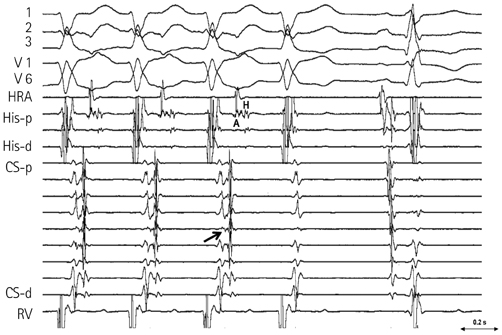Korean Circ J.
2014 Jul;44(4):271-273. 10.4070/kcj.2014.44.4.271.
Supraventricular Tachycardia and Sinus Rhythm with Contralateral Bundle Branch Block Patterns
- Affiliations
-
- 1Krannert Institute of Cardiology, Indiana University School of Medicine, Indianapolis, IN, USA. midas@iupui.edu
- KMID: 2223890
- DOI: http://doi.org/10.4070/kcj.2014.44.4.271
Abstract
- A contralateral bundle branch block (BBB) aberration during tachycardia with a preexisting BBB strongly suggests the presence of ventricular tachycardia. We report on a middle-aged, female patient presented with wide QRS tachycardia. The patient had orthodromic atrioventricular tachycardia with a left BBB aberration in the presence of a preexisting right BBB due to an abnormal His-Purkinje system. We learned that the contralateral BBB aberration with supraventricular tachycardia could be seen when the His-Purkinje system was abnormal.
MeSH Terms
Figure
Reference
-
1. Approach to wide QRS tachycardias. In : Issa Z, Miller J, Zipes D, editors. Clinical arrhythmology and electrophysiology. 1st ed. Philadelphia: WB Saunders;2009. p. 398.2. de P.dua F, Pereirinha A, Marques N, Lopes MG, Macfarlane PW. Chapter 14. Conduction defect. In : Macfarlane PW, Oosterom A, Pahlm O, Kligfield P, Janse M, Camm J, editors. Comprehensive Electrocardiology. 2nd ed. London: Springer;2011. p. 554.3. Demoulin JC, Kulbertus HE. Histopathological examination of concept of left hemiblock. Br Heart J. 1972; 34:807–814.
- Full Text Links
- Actions
-
Cited
- CITED
-
- Close
- Share
- Similar articles
-
- Preexcitation Syndrome with a Mahaim-type Accessory Pathway
- A Case of Hyperthyroidism with Complete Atrioventricular Block and Cardiac Arrest
- Differential Diagnosis of Supraventricular Tachycardia
- Rate-dependent Left Bundle Branch Block during General Anesthesia : A case report
- Studies on Electrocardiogram of 18,000 Koreans





